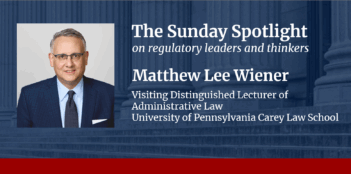
The REINS Act, the ozone standard, regulatory reform, cost-benefit analysis, the Affordable Care Act, and Dodd-Frank, and more … as discussed in our top opinion posts from 2011.
As 2011 draws to a close, The Regulatory Review reflects back on a year of major regulatory developments around the world. For our daily essay today, as well as our essays for yesterday and two days ago, we feature the top 50 essays of the past twelve months, based on the number of page views. Today we feature the top opinion essays from among our top overall essays, while yesterday and two days ago we featured the top analysis and news essays, respectively.
 A recent judgment of the Court of Justice of the European Union in a case called Gowan seems to confirm the most pessimistic views from both sides of the Atlantic about the dangers of the precautionary principle. According to this principle, nations are justified adopting protective regulatory measures in situations of scientific uncertainty. However, the principle’s detractors argue that it offers limited guidance to policymakers and worryingly expands regulatory discretion, thereby risking illegitimate dominance of the state over its citizens.
A recent judgment of the Court of Justice of the European Union in a case called Gowan seems to confirm the most pessimistic views from both sides of the Atlantic about the dangers of the precautionary principle. According to this principle, nations are justified adopting protective regulatory measures in situations of scientific uncertainty. However, the principle’s detractors argue that it offers limited guidance to policymakers and worryingly expands regulatory discretion, thereby risking illegitimate dominance of the state over its citizens. Privacy is a key to a host of goods of which moral self-respect, trusting relationships, and positions of responsibility are but a critical few. The “right to privacy” should be thought of, not just as a right to the privacy we may happen to want today, but as a right to the privacy we may need in order to flourish for a lifetime. The moral and legal resources of the nation are properly applied to insuring the protection of privacy, even the unpopular kind that may have to be forced on us.
Privacy is a key to a host of goods of which moral self-respect, trusting relationships, and positions of responsibility are but a critical few. The “right to privacy” should be thought of, not just as a right to the privacy we may happen to want today, but as a right to the privacy we may need in order to flourish for a lifetime. The moral and legal resources of the nation are properly applied to insuring the protection of privacy, even the unpopular kind that may have to be forced on us. Over the past sixty years, the amount of federal regulatory activity, as measured by pages in the Federal Register, has increased more than six-fold. This growth in federal regulation has been facilitated by the legislative practice of delegating regulatory authority and policy discretion to federal agencies. Over time, Congress has turned over ever-greater amounts of regulatory authority to an ever-expanding array of federal agencies. Congress has often had good reasons to delegate. The economic, environmental and other problems Congress has sought to address were are complicated and often necessitate careful study and analysis. Delegation of regulatory authority to expert agencies with the time and expertise to focus on specific problems may help ensure that federal regulations achieve their intended aims.
Over the past sixty years, the amount of federal regulatory activity, as measured by pages in the Federal Register, has increased more than six-fold. This growth in federal regulation has been facilitated by the legislative practice of delegating regulatory authority and policy discretion to federal agencies. Over time, Congress has turned over ever-greater amounts of regulatory authority to an ever-expanding array of federal agencies. Congress has often had good reasons to delegate. The economic, environmental and other problems Congress has sought to address were are complicated and often necessitate careful study and analysis. Delegation of regulatory authority to expert agencies with the time and expertise to focus on specific problems may help ensure that federal regulations achieve their intended aims. This morning President Obama issued a new executive order on regulation. The order reaffirms many core principles of regulatory policymaking reflected in prior executive orders dating back to the Reagan Administration. It also keeps in place the existing structure of White House review of new regulations that had been established by President Clinton.
This morning President Obama issued a new executive order on regulation. The order reaffirms many core principles of regulatory policymaking reflected in prior executive orders dating back to the Reagan Administration. It also keeps in place the existing structure of White House review of new regulations that had been established by President Clinton. As Stuart Shapiro recently pointed out in a The Regulatory Review essay, President Obama himself made the decision a week ago to withdraw the U.S. Environmental Protection Agency’s (EPA’s) ozone National Ambient Air Quality Standard (NAAQS). Presidents have occasionally acted to resolve disputes between the White House Office of Information and Regulatory Affairs (OIRA) and EPA before, but typically OIRA acts in the President’s name without knowing exactly what he thinks about the regulatory details that OIRA negotiates with EPA. Stuart Shapiro also correctly points out that the President’s substitution of his general policy judgment for a judgment of an agency charged by Congress with the responsibility to implement a statute’s policy has implications for administrative law.
As Stuart Shapiro recently pointed out in a The Regulatory Review essay, President Obama himself made the decision a week ago to withdraw the U.S. Environmental Protection Agency’s (EPA’s) ozone National Ambient Air Quality Standard (NAAQS). Presidents have occasionally acted to resolve disputes between the White House Office of Information and Regulatory Affairs (OIRA) and EPA before, but typically OIRA acts in the President’s name without knowing exactly what he thinks about the regulatory details that OIRA negotiates with EPA. Stuart Shapiro also correctly points out that the President’s substitution of his general policy judgment for a judgment of an agency charged by Congress with the responsibility to implement a statute’s policy has implications for administrative law. Although regulations affect every aspect of our lives, they rarely reach the attention of voters (and consequently of elected officials) because, unlike their spending cousins, their effects are often not visible. Like the direct government spending that is supported by taxes, regulations are designed to achieve social goals, but the costs of regulations are hidden in higher prices paid for goods and services and in opportunities foregone.
Although regulations affect every aspect of our lives, they rarely reach the attention of voters (and consequently of elected officials) because, unlike their spending cousins, their effects are often not visible. Like the direct government spending that is supported by taxes, regulations are designed to achieve social goals, but the costs of regulations are hidden in higher prices paid for goods and services and in opportunities foregone. President Obama’s announcement yesterday of his nominee to head the new Consumer Financial Protection Bureau (CFPB) makes a nearly decade-old suggestion particularly timely.
President Obama’s announcement yesterday of his nominee to head the new Consumer Financial Protection Bureau (CFPB) makes a nearly decade-old suggestion particularly timely. For at least 30 years, U.S. presidents have required federal agencies to use benefit-cost analysis (BCA) when developing new regulations. Members of Congress from both political parties have also favored BCA. Yet despite the strong bipartisan support for a strong role for BCA in federal regulatory policy, critics of BCA object to its role by invoking a series of popular misconceptions. I would like to dispel five of the most popular misconceptions about BCA.
For at least 30 years, U.S. presidents have required federal agencies to use benefit-cost analysis (BCA) when developing new regulations. Members of Congress from both political parties have also favored BCA. Yet despite the strong bipartisan support for a strong role for BCA in federal regulatory policy, critics of BCA object to its role by invoking a series of popular misconceptions. I would like to dispel five of the most popular misconceptions about BCA. Doomsayers have referred to growing debt from college loans as the second coming of the subprime crisis. They warn that an entire industry is on the verge of collapse, threatening to dash the dreams of over 3 million students on the rocky edges of debt.
Doomsayers have referred to growing debt from college loans as the second coming of the subprime crisis. They warn that an entire industry is on the verge of collapse, threatening to dash the dreams of over 3 million students on the rocky edges of debt. Republicans in both the House and Senate have introduced legislation that would dramatically change the way our laws are implemented. Their proposed REINS Act – an acronym for “Regulations from the Executive in Need of Scrutiny” – would require both Houses of Congress and the President to approve virtually all new major regulations, the same basic process needed to enact ordinary legislation.
Republicans in both the House and Senate have introduced legislation that would dramatically change the way our laws are implemented. Their proposed REINS Act – an acronym for “Regulations from the Executive in Need of Scrutiny” – would require both Houses of Congress and the President to approve virtually all new major regulations, the same basic process needed to enact ordinary legislation.
 Requirements for economic analysis of important regulatory proposals have been around at least since President Nixon established a “Quality of Life Review” program for certain high-profile regulations. Beginning in 1981, with President Reagan’s Executive Order on regulatory review, and continuing through to President Obama’s Executive Order earlier this year, all Presidents — both Republicans and Democrats — have required regulatory agencies within the Executive Branch to assess the costs and benefits of proposed actions. Some members of Congress are now consid ering whether to codify the terms of executive orders and to authorize the courts to review agencies’ economic analysis. Having served as the Administrator of the Office of Information and Regulatory Affairs (OIRA) at the Office of Management and Budget (OMB) for the first five years of the Clinton Administration, I am a staunch supporter of requiring regulatory agencies to conduct economic analysis and of having
Requirements for economic analysis of important regulatory proposals have been around at least since President Nixon established a “Quality of Life Review” program for certain high-profile regulations. Beginning in 1981, with President Reagan’s Executive Order on regulatory review, and continuing through to President Obama’s Executive Order earlier this year, all Presidents — both Republicans and Democrats — have required regulatory agencies within the Executive Branch to assess the costs and benefits of proposed actions. Some members of Congress are now consid ering whether to codify the terms of executive orders and to authorize the courts to review agencies’ economic analysis. Having served as the Administrator of the Office of Information and Regulatory Affairs (OIRA) at the Office of Management and Budget (OMB) for the first five years of the Clinton Administration, I am a staunch supporter of requiring regulatory agencies to conduct economic analysis and of havingtheir work reviewed by OIRA. But I have serious reservations about codifying these requirements and providing for judicial review of agencies’ economic analysis.
 President Obama’s opposition to tightening the national ambient air quality standards for ozone standard is a bad thing. The Environmental Protection Agency’s (EPA) Scientific Advisory Board recommended, both in the current and George W. Bush administrations, that the standard be set between 60 and 70 parts per billion to protect public health from premature deaths, heart attacks, and countless asthma attacks among those who spend a lot of time outside. The Bush Administration, though, established the standard at 75, saying there was too much scientific uncertainty to warrant a tighter standard. President Obama’s decision in effect endorses this view.
President Obama’s opposition to tightening the national ambient air quality standards for ozone standard is a bad thing. The Environmental Protection Agency’s (EPA) Scientific Advisory Board recommended, both in the current and George W. Bush administrations, that the standard be set between 60 and 70 parts per billion to protect public health from premature deaths, heart attacks, and countless asthma attacks among those who spend a lot of time outside. The Bush Administration, though, established the standard at 75, saying there was too much scientific uncertainty to warrant a tighter standard. President Obama’s decision in effect endorses this view. According to the conventional wisdom, the 2,319 pages of the Dodd-Frank Act are an incoherent mess, and the new financial legislation leaves nearly all of the key issues to the discretion of regulators. The first half of this wisdom is wrong, but the second half points to a serious problem for financial regulation in the coming years.
According to the conventional wisdom, the 2,319 pages of the Dodd-Frank Act are an incoherent mess, and the new financial legislation leaves nearly all of the key issues to the discretion of regulators. The first half of this wisdom is wrong, but the second half points to a serious problem for financial regulation in the coming years. Last week’s 11th Circuit Court of Appeals decision striking down the individual health insurance mandate in the Patient Protection and Affordable Care Act is an important milestone. As the first appellate court to invalidate the law, the 11th Circuit panel correctly recognized that there is no way to uphold the mandate without giving Congress unlimited power to mandate anything.
Last week’s 11th Circuit Court of Appeals decision striking down the individual health insurance mandate in the Patient Protection and Affordable Care Act is an important milestone. As the first appellate court to invalidate the law, the 11th Circuit panel correctly recognized that there is no way to uphold the mandate without giving Congress unlimited power to mandate anything. As Congress considers whether to codify cost-benefit analysis (CBA) requirements, federal agencies and observers of the regulatory process should recognize that existing CBA procedures systematically undervalue the benefits of regulation, causing widespread underregulation of environmental harms and other health hazards.
As Congress considers whether to codify cost-benefit analysis (CBA) requirements, federal agencies and observers of the regulatory process should recognize that existing CBA procedures systematically undervalue the benefits of regulation, causing widespread underregulation of environmental harms and other health hazards.


